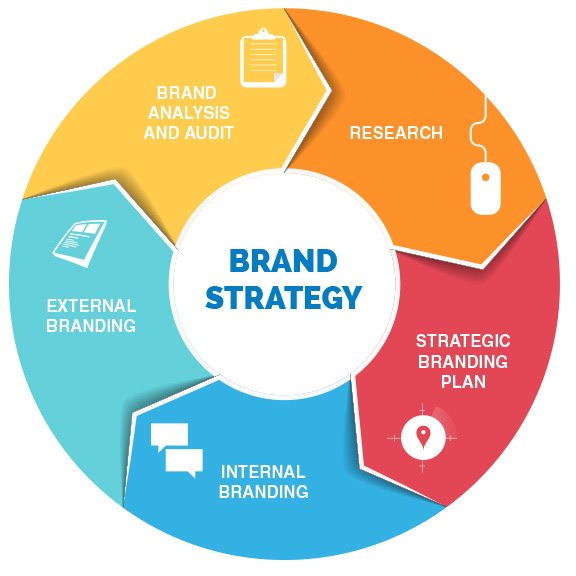Brand Strategy
Table of Contents
What is a Brand?
There are a million definitions of a “brand.” Often, when people talk about a “brand,” they’re referring to the physical mark (or logo) imprinted on something to identify the business that manufactured it. But a brand is more than a physical mark. It’s an emotional mark—more specifically, an emotional experience, strengthened or weakened through every interaction with that business.
We define brand as what people think, feel, and say about your business. (This differs from marketing, which is what you say about your business.)
What about Branding? Branding is one of the most critical aspects of business strategy and provides a sustainable competitive advantage. Branding allows a business to differentiate its products and services from those of its competitors’. The digital economy has made it easier for small businesses to gain access to branding experts and leverage branding in a meaningful way.


What is Brand Strategy?
To understand brand strategy, one must first understand branding.
In simple terms, branding is the process of quantifying the value and authenticity of an organization, product, or service. It is a clear set of characteristics, benefits, and attributes that define a particular brand. Many people are often confused about branding and marketing.
Branding is what drives marketing because branding is strategic and marketing is tactical.
In contrast, brand strategy defines rules and guidelines on how, what, where, when and to whom you communicate your brand messages. A well-defined and executed brand strategy leads to a consistent brand message, a strong emotional connection with customers, and higher brand equity.
Why Do You Need A Brand Strategy?
We live in a world that is driven by perception and brands represent customers’ opinion of a company’s credibility, products, reputation and customer experience. A brand strategy is essential because it provides clarity about the competitive landscape, market position and customer expectations. This information is critical to develop effective marketing strategies and to fine-tune marketing messages to maximize your competitiveness and build strong brands. Branding significantly enhances the brand’s market performance and profitability by improving name recognition, building credibility and trust, increasing advertising effectiveness and inspiring employees.
a brand strategy is “a plan for the systematic development of brand in alignment with a business strategy.”
A brand strategy helps you understand who you are and acts as a blueprint to help you communicate it.
Our brand strategy process is broken into three distinct parts. We guide you from your Brand Heart (the core of your brand), to the articulation of your Brand Messaging (how you talk about who you are), to your Brand Identity (the visual expression of your brand). By the end, you’ll have a full brand strategy, summed up in fresh brand guidelines to help you bring your brand to life.
How We Can Help
We help businesses of all types develop their brand strategy by learning about their business, history, and goals. We understand that branding goes way beyond just a business logo or color scheme.
Our Approach
We develop brand strategies that clearly identify short-term and long-term goals, communication channels and impact on brand equity. The brand message is refined to make sure it is aligned with the mission and values of the brand. A clear brand message is a key to bridge the gap between brand strategy and brand messaging.
- We start by learning about you, what makes your business unique, your strengths and weaknesses, competition, target audience, and opportunities.
- We perform a comprehensive review of your marketing communications to evaluate your existing brand identity.
- We review the brand’s value proposition as well as positioning.
- We identify and define attributes that set your brand apart from competitors and how to leverage these attributes to gain a sustainable competitive advantage.
- We use our keen understanding of digital, social and mobile marketing as well as traditional marketing to develop a brand message that is consistent and coherent with the overall brand strategy.
- We review visual identity elements such as logos, taglines, and colors to make sure they align with your business objectives.
- We then develop a comprehensive branding strategy and a new brand identity incorporating changes identified by the brand audit and discovery sessions.
- We make sure that marketing strategy is aligned with the branding strategy.
What We Offer
- Brand Purpose
- Brand Vision
- Brand Values
- Target Audience
- Market Analysis
- Awareness Goals
- Brand Personality
- Brand Voice
- Brand Tagline

The 9 Brand Strategy Elements:
Here is a list of nine components that are fundamental for forming an effective brand strategy.
1. Brand Purpose
First, you need to know why you’re in business and talk about it to rally your team and foster connection with your audience.
It is simply the WHY behind what you do as a brand, aside from the obvious reason.
When your brand has a clear purpose, it will help you:
- Attract cult-like following
- Makes more sales
- Grows faster
- Get better ROI
So finding your brand purpose is the first and probably the most important elements of developing an effective brand strategy.
2. Brand Vision
Second, you need to Influence long-term business decision to ensure the brand is navigated towards the right direction.
Having a clear vision helps you in determining your goals for growth, and will directly influence your business decisions.
You must have a bold vision that can challenge and motivate you and your team, but at the same time your vision must be realistic, so that people will believe in getting there.
When your define a vision, it helps you:
- Dream big and inspire people
- Make meaningful business decisions
- Stay on track and “on brand”
A brand’s vision, after its purpose, is the next in order key element of branding a business the strategic way.
3. Brand Values
Third, you need to determine your core values and create a culture and driving force for what to stand for in the world.
By defining you core values, you can determine how your brand will be perceived in the marketplace.
This is allow you to guide communication and decision-making so that your brand remains consistent.
Your brand values will show customers, suppliers, and the general public what the business stands for.
Just like the other two elements of brand strategy, your brand values guide your brand internally and helps with decision making.
4. Target Audience
Four, you need to understand your audience well so that you can address their problems and needs with relevant solutions.
Knowing your target audience is key to positioning your brand in the market.
In the positioning section of your brand strategy, the most important component is defining your target audience and uncovering details about their lives.
You can start defining your target audience by building a profile of your average target customers.
This should include their demographics, problems they face, emotional inclinations as well as behavioral patterns.
Most importantly, you must discover their aspirations, hopes, objectives, and goals, so that you can position your product/service as a something they want and need.
5. Market Analysis
Look for gaps in the market to find what differentiates you and how you can stand out or stand for something.
Analyzing the marketplace will help you differentiate your brand from the pack.
A market analysis is the second very important step in the process of positioning your brand among your competitors.
There are new brands are being created every single day and almost each industry is very crowded and competitive.
That’s why you need to analyze the marketplace and know the strengths and weaknesses of you competitors.
You must look for areas where you can set yourself apart from others, so that your audience can remember you among your competition.
Therefore researching your competitive landscape is a very important element of developing an effective brand strategy.
6. Awareness Goals
Brainstorm and prioritize how customers will learn about your brand.
Prioritizing awareness goals and initiatives will help you market more effectively.
Next in line for the key elements of a brand strategy are your brand’s marketing goals.
The purpose of this element is decide how you’ll create awareness, so that your target audience can discover your brand.
This element of your strategy will help with you reach to and and get in front of prospective customers.
In this step, you also need to consider the cost and difficulty of each marketing initiative so that you can spend your marketing money wisely.
Together with the target audience, and market research, your goals can help you in getting the word out there.
7. Brand Personality
Give your brand a human side by defining its personality to build relationships with your customers.
Defining your brand personality will help you resonate with your audience.
Most startups overlook the importance of giving their brand more character and a human-like personality.
It is extremely important to humanize your brand, so that people can feel that real connection.
Describing your brand as if it was a person, will help you form opinions and attitudes and therefor build relationships with like-minded audience.
8. Brand Voice
Define your tone of voice to set guidelines for how you want to sound to your target audience.
Projecting a compelling voice is essential to deliver your brand message.
Once you have discovered the personality of your brand, the next step is to complement it with an appropriate tone of voice.
The tone in which a brand speak to its customers will vary from brand to brand.
For example: a bank will speak in a more formal and professional manner, while a new brand that caters to millennials can be more friendly and funny.
Whatever voice is appropriate for your brand, you must make sure you use it consistently across all channels of communication.
9. Brand Tagline
Distill your message into a few concise and memorable words that can tell your brand story.
Crafting a memorable tagline will help you tell your brand story in just a few, short words.
It is important to choose a tagline that conveys the message of your brand in reflects brand positioning.
Once you have worked out all the other key elements of your brand strategy, it’s time to sum it all up in just a few memorable words.
